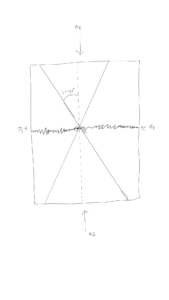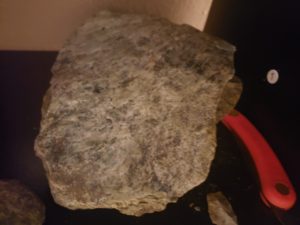Dirty Harry Geology Minute
2019-08-21
I was inspired to write this post from one of my favorite podcasts “Dirty Harry Minute” that watches and reviews every minute of Dirty Harry in order. Link in the Citations [6]
So, there are two main Geology things I’ve noticed in Dirty Harry. They are like bookends of the film, one at the beginning, one at the end, clearly showing that Geology is the real important thing in this film. This is definitely not based on my Pro-Geology bias.
Stylish Stylolites
So, the opening scene of Dirty Harry shows the memorial wall for fallen San Francisco Police Officers. You’ll notice that the rock is predominantly pink, but has black lines running through it. These black lines actually extend through the whole rock in a rough plane and are called “Stylolites”

So how do Stylolites form? Well, first we’re going to learn about Stress and Strain. So here’s the diagram I’m going to teach you off of, copied from Fossen [4], though this diagram is found everywhere you want to learn about Shear fractures. The σ here represents a principal strain axis, so σ1 is the highest strain axis and σ3 is the lowest strain axis.

So as we see from this diagram, some weird squiggly line forms perpendicular to σ1 and on the plane defined by σ2 and σ3. This is a Stylolite. So from this diagram, we know that Stylolites are formed by pressure, and because of this, we can use the stylolites tell where the strain axis is using a Stereonet (I’m pretty sure I’m the only one who liked doing them in college, I even used them at Field Camp).
They are formed by dissolution of minerals, and the black lines are from the insoluble minerals. The dissolved minerals are, of course, whisked away by the water.
Then, after this happened, the stone lay buried until someone came along, dug it up, polished it and engraved it. Once you learn about Stylolites you start noticing them everywhere, for example, I recently had to go to the Spokane County Courthouse to register a car, and the floor was covered in Stylolites. And if you’re ever at my Alma Mater, there are Stylolites in some of the bathrooms of the Geology Department (One of the Structures Professors used to take classes into the Men’s room until a parent visited and she realized it was kind of weird to bring students to the bathroom).
Quite a Quarry
The Finale of Dirty Harry takes place in a quarry, so of course, I wanted to figure out what exactly they were extracting. So I Googled it and came to a site that talks about the filming locations of Dirty Harry [1]. This then led me to a short summary entitled “The Geologic Foundations of Ring Mountain” by Professor Jim Locke [2]. I then tracked down the Location on Macrostrat [3]. We’ll use Macrostrat to give us a general view and Locke for an in-depth view.
So, like much this part of California, it’s got the Franciscan Complex which is a Melange of highly metamorphosed rocks that are very characteristic of the construction of California. A fun fact about the Franciscan formation: A large part of it is composed of serpentinite, which is California’s State Rock and is mined for its Asbestos. The existence of this rock in the Franciscan Complex helps tell its history, as it is only formed under very specific circumstances.

According to Klein and Dutrow [4], Serpentinite is a rock that forms through retrograde metamorphism, which, simplistically means a rock that was formed under high temps then metamorphosed under lower temps with the help of some volatiles, resulting in the elements rearranging into a form that’s more stable at that lower temperature.
Chemical formula is 4 Mg2SiO4(Forsterite) + 6H2O(Water) >> Mg6Si4O10(OH)8(Serpentinite) + 2Mg(OH)2(Brucite). What this means, is that we have a rock that was formed at high temperatures (Forsterite is an Olivine, which, according to Bowen’s Reaction Series has a high temperature of formation, so would be found in a Basalt, which is a common ocean floor rock), then was flooded with water for it’s metamorphism.
Now, of course, The Franciscan Complex is, well, complex, and has many variations on its occurrences. In Locke, he mentions that the lightly colored rocks seen in the final shootout are from a Rhyolite Dike that cut through the quarry. Rhyolite is a felsic rock (High Silicon Dioxide content low iron and magnesium content) that is highly viscous.
Locke also shows a picture of a pyritized vein which contained slickensides. So pyritized means that the vein has been altered to contains Iron Sulfide (The mineral Pyrite, which is known as Fools Gold because of its metallic luster and yellow color). The Slickensides are created by movement along a fault and are characterized by the smooth layers they create with lineations (Slickenlines) which help show the direction of movement. The fault movement will crush the rock creating a polished surface which is the slickenside. [5]. I’ll have a picture of a Slickenside from the Franciscan Formation in a few days, I tried uploading the one on my Hard Drive and it didn’t work.
This all describes the formation of California, the Franciscan Complex was formed through the repeated orogenies (Mountain building events).
Conclusion
So, we can see, the running theme throughout this movie is pressure. In the beginning, Harry faces pressure to find the Scorpio Killer, whereas, in the end, he faces the pressure to shoot him in the face. This also is a metaphor for how the movie takes place at low temperatures. At no point in the film do any of the characters burst into flames or melt.
Citations
- https://dirtyharryfilminglocations.wordpress.com/finale-hutchinson-co-quarry-larkspur-landing-ca/
- http://www.marin.edu/~jim/ring/rgeo.html
- https://macrostrat.org/map/#/z=13.7/x=-122.4967/y=37.9483/bedrock/lines/
- 23rd Edition of Mineral Science by Klein and Dutrow
- Structural Geology by Haakon Fossen
- https://dirtyharryminute.com/wp/
Recent Comments